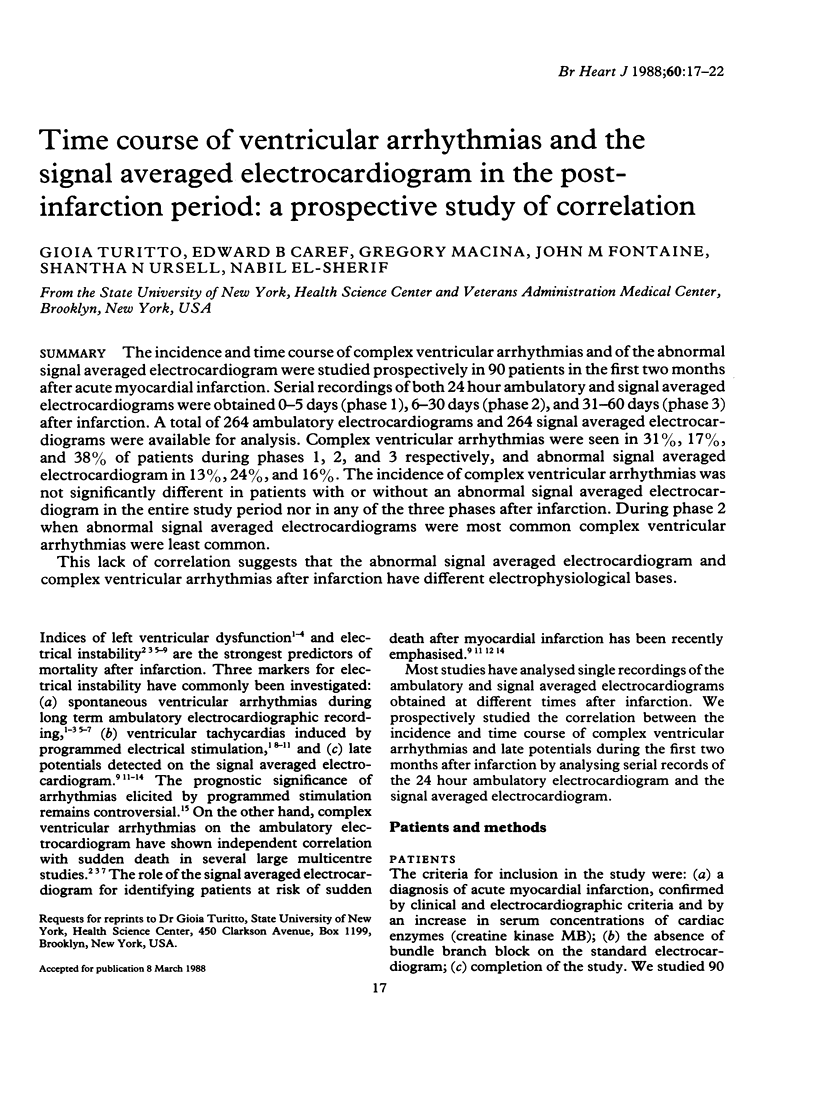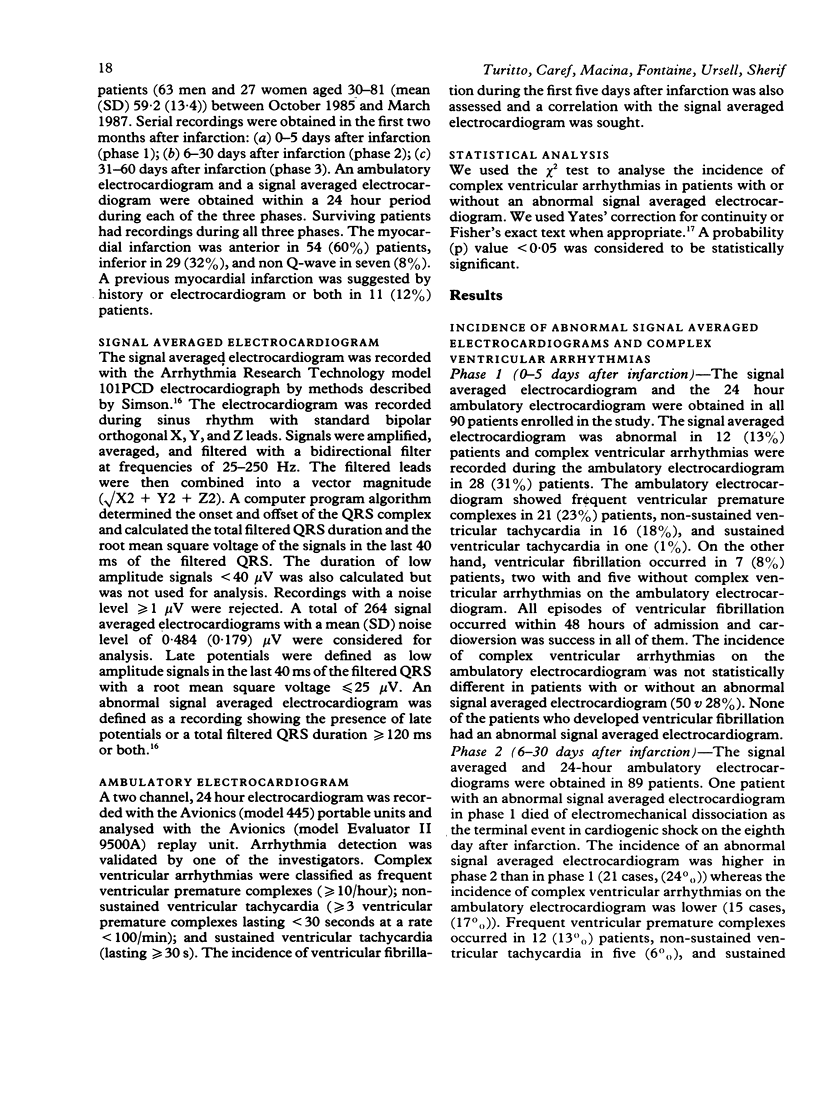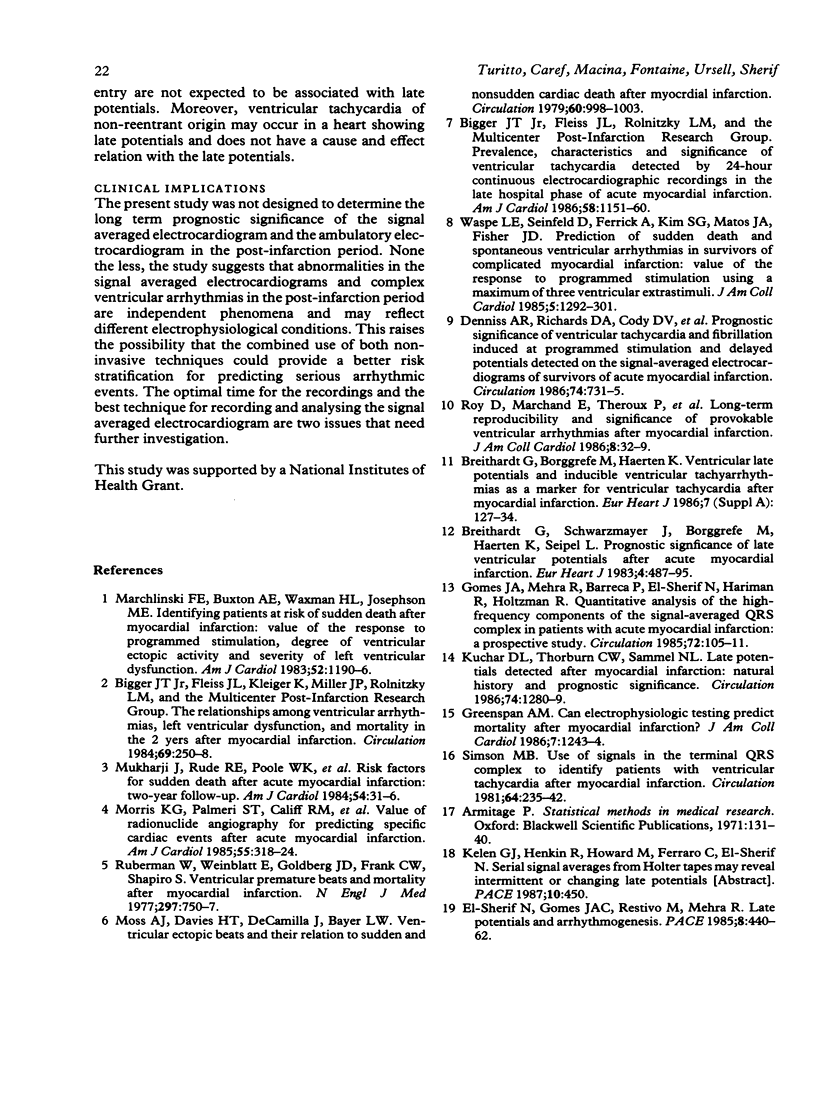Abstract
The incidence and time course of complex ventricular arrhythmias and of the abnormal signal averaged electrocardiogram were studied prospectively in 90 patients in the first two months after acute myocardial infarction. Serial recordings of both 24 hour ambulatory and signal averaged electrocardiograms were obtained 0-5 days (phase 1), 6-30 days (phase 2), and 31-60 days (phase 3) after infarction. A total of 264 ambulatory electrocardiograms and 264 signal averaged electrocardiograms were available for analysis. Complex ventricular arrhythmias were seen in 31%, 17%, and 38% of patients during phases 1, 2, and 3 respectively, and abnormal signal averaged electrocardiogram in 13%, 24%, and 16%. The incidence of complex ventricular arrhythmias was not significantly different in patients with or without an abnormal signal averaged electrocardiogram in the entire study period nor in any of the three phases after infarction. During phase 2 when abnormal signal averaged electrocardiograms were most common complex ventricular arrhythmias were least common. This lack of correlation suggests that the abnormal signal averaged electrocardiogram and complex ventricular arrhythmias after infarction have different electrophysiological bases.
Full text
PDF





Selected References
These references are in PubMed. This may not be the complete list of references from this article.
- Bigger J. T., Jr, Fleiss J. L., Kleiger R., Miller J. P., Rolnitzky L. M. The relationships among ventricular arrhythmias, left ventricular dysfunction, and mortality in the 2 years after myocardial infarction. Circulation. 1984 Feb;69(2):250–258. doi: 10.1161/01.cir.69.2.250. [DOI] [PubMed] [Google Scholar]
- Breithardt G., Borggrefe M., Haerten K. Ventricular late potentials and inducible ventricular tachyarrhythmias as a marker for ventricular tachycardia after myocardial infarction. Eur Heart J. 1986 May;7 (Suppl A):127–134. [PubMed] [Google Scholar]
- Breithardt G., Schwarzmaier J., Borggrefe M., Haerten K., Seipel L. Prognostic significance of late ventricular potentials after acute myocardial infarction. Eur Heart J. 1983 Jul;4(7):487–495. doi: 10.1093/oxfordjournals.eurheartj.a061506. [DOI] [PubMed] [Google Scholar]
- Denniss A. R., Richards D. A., Cody D. V., Russell P. A., Young A. A., Cooper M. J., Ross D. L., Uther J. B. Prognostic significance of ventricular tachycardia and fibrillation induced at programmed stimulation and delayed potentials detected on the signal-averaged electrocardiograms of survivors of acute myocardial infarction. Circulation. 1986 Oct;74(4):731–745. doi: 10.1161/01.cir.74.4.731. [DOI] [PubMed] [Google Scholar]
- Gomes J. A., Mehra R., Barreca P., el-Sherif N., Hariman R., Holtzman R. Quantitative analysis of the high-frequency components of the signal-averaged QRS complex in patients with acute myocardial infarction: a prospective study. Circulation. 1985 Jul;72(1):105–111. doi: 10.1161/01.cir.72.1.105. [DOI] [PubMed] [Google Scholar]
- Greenspan A. M. Can electrophysiologic testing predict mortality after myocardial infarction? J Am Coll Cardiol. 1986 Jun;7(6):1243–1244. doi: 10.1016/s0735-1097(86)80142-5. [DOI] [PubMed] [Google Scholar]
- Kuchar D. L., Thorburn C. W., Sammel N. L. Late potentials detected after myocardial infarction: natural history and prognostic significance. Circulation. 1986 Dec;74(6):1280–1289. doi: 10.1161/01.cir.74.6.1280. [DOI] [PubMed] [Google Scholar]
- Marchlinski F. E., Buxton A. E., Waxman H. L., Josephson M. E. Identifying patients at risk of sudden death after myocardial infarction: value of the response to programmed stimulation, degree of ventricular ectopic activity and severity of left ventricular dysfunction. Am J Cardiol. 1983 Dec 1;52(10):1190–1196. doi: 10.1016/0002-9149(83)90572-6. [DOI] [PubMed] [Google Scholar]
- Morris K. G., Palmeri S. T., Califf R. M., McKinnis R. A., Higginbotham M. B., Coleman R. E., Cobb F. R. Value of radionuclide angiography for predicting specific cardiac events after acute myocardial infarction. Am J Cardiol. 1985 Feb 1;55(4):318–324. doi: 10.1016/0002-9149(85)90368-6. [DOI] [PubMed] [Google Scholar]
- Moss A. J., Davis H. T., DeCamilla J., Bayer L. W. Ventricular ectopic beats and their relation to sudden and nonsudden cardiac death after myocardial infarction. Circulation. 1979 Nov;60(5):998–1003. doi: 10.1161/01.cir.60.5.998. [DOI] [PubMed] [Google Scholar]
- Mukharji J., Rude R. E., Poole W. K., Gustafson N., Thomas L. J., Jr, Strauss H. W., Jaffe A. S., Muller J. E., Roberts R., Raabe D. S., Jr Risk factors for sudden death after acute myocardial infarction: two-year follow-up. Am J Cardiol. 1984 Jul 1;54(1):31–36. doi: 10.1016/0002-9149(84)90299-6. [DOI] [PubMed] [Google Scholar]
- Roy D., Marchand E., Théroux P., Waters D. D., Pelletier G. B., Cartier R., Bourassa M. G. Long-term reproducibility and significance of provokable ventricular arrhythmias after myocardial infarction. J Am Coll Cardiol. 1986 Jul;8(1):32–39. doi: 10.1016/s0735-1097(86)80088-2. [DOI] [PubMed] [Google Scholar]
- Ruberman W., Weinblatt E., Goldberg J. D., Frank C. W., Shapiro S. Ventricular premature beats and mortality after myocardial infarction. N Engl J Med. 1977 Oct 6;297(14):750–757. doi: 10.1056/NEJM197710062971404. [DOI] [PubMed] [Google Scholar]
- Simson M. B. Use of signals in the terminal QRS complex to identify patients with ventricular tachycardia after myocardial infarction. Circulation. 1981 Aug;64(2):235–242. doi: 10.1161/01.cir.64.2.235. [DOI] [PubMed] [Google Scholar]
- Waspe L. E., Seinfeld D., Ferrick A., Kim S. G., Matos J. A., Fisher J. D. Prediction of sudden death and spontaneous ventricular tachycardia in survivors of complicated myocardial infarction: value of the response to programmed stimulation using a maximum of three ventricular extrastimuli. J Am Coll Cardiol. 1985 Jun;5(6):1292–1301. doi: 10.1016/s0735-1097(85)80339-9. [DOI] [PubMed] [Google Scholar]
- el-Sherif N., Gomes J. A., Restivo M., Mehra R. Late potentials and arrhythmogenesis. Pacing Clin Electrophysiol. 1985 May;8(3 Pt 1):440–462. doi: 10.1111/j.1540-8159.1985.tb05784.x. [DOI] [PubMed] [Google Scholar]


